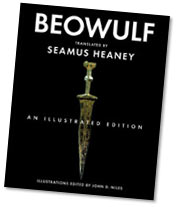Beowulf’s world comes to life in new book

English professor John D. Niles edited the images for Beowulf: An Illustrated Edition, released in early November.
A new Hollywood film opening in theatres Friday employs special-effects wizardry to tell the story of Beowulf, but a just-released illustrated edition of the epic tale from a UW English professor comes much closer to showing us the world where the action takes place.
John D. Niles spent two years compiling more than 120 images that illuminate the earliest major narrative poem in the English language. Beowulf: An Illustrated Edition includes renderings of Viking-age war ships as well as photographs of sixth-century weapons, armor and jewelry. The book, which includes the celebrated translation by Seamus Heaney, also uses photos of landscapes and scenery from southern Scandinavia, where much of the story is set, to evoke a sense of place throughout the poem.
The release of the book and the movie directed by Robert Zemeckis represents the zenith of what Niles calls a “Beowulf boom” surrounding the story. The poem tells of a hero who saves the Danes from the demon Grendel and the creature’s mother, then dies many years later while slaying a flying, fire-breathing dragon that threatens to destroy his people. (story continues)
Slide show: Beowulf images

Helmet from Sutton Hoo, Suffolk. The hero Beowulf is never described in physical detail and remains fairly inscrutable. Since 1939, though, when the treasures buried at Sutton Hoo were unearthed, many people have been tempted to associate the poem with objects found at that site. This helmet, for some present-day readers, may be as close to the man “Beowulf” as one can get. (Copyright: Trustees of the British Museum, London)

Replica of lyre from Mound 1 at Sutton Hoo, Suffolk. Lyres have occasionally been found in high-status pagan graves of the late Germanic Iron Age. People of this era clearly enjoyed music and song, as they are shown doing at the beginning of "Beowulf" when a court singer celebrates the Creation. This lyre had six strings and was made of beech wood. (Copyright: Trustees of the British Museum, London)

With its portrayal of two warriors fighting a dragon — an older man fighting from above and a younger man from below — this illustration from a 13th-century French manuscript reminds one of the action of “Beowulf.” Collage by Benjamin Slade, juxtaposing an image from Dijon Municipal Library MS 168, fol. 4b, against the first page of the “Beowulf” manuscript. (Collage copyright: Benjamin Slade.)

Beowulf’s father, Ecgtheow, was once exiled from his homeland for having killed a man of very high rank. King Hrothgar settled the feud by paying compensation for the dead man. This gold hoard from Broholm, on the island of Funen, would have sufficed to pay off even the greatest of feuds. It is the largest collection of gold objects from the Migration Age in Denmark. (Copyright: National Museum of Denmark, Copenhagen.)

Portrait of a demon at hell mouth, from an Anglo-Saxon illuminated manuscript of “Wonders of the East.” The demon’s eyes are painted a brilliant red as if giving off flames. Similarly, Grendel represents evil incarnate, and “a baleful light, / flame more than light, flared from his eyes” (lines 726-27). (Copyright: British Library, London.)

Beowulf proves his credentials for the Grendel fight by recounting the details of an earlier exploit when he and a prince named Breca vied with one another in a contest on the high seas. This stylized head of a sea-beast, recovered from the River Schelde in Belgium, suggests the nature of the monsters that harried him, in his account of the events. (Copyright: Trustees of the British Museum, London.)
Story continued from above
“It speaks to certain essential aspects of the human condition: death, divine power, horror, exultation, disgrace, personal devotion, fame. You don’t have to be an aristocratic warrior from the first millennium to be able to relate to the human issues,” Niles says.
Listen to Beowulf
UW Digital Collections published in 2005 Beowulf: A New Translation for Oral Delivery by Dick Ringler, emeritus professor of English and Scandinavian studies. The collection includes online audio of a reading of Ringler’s translation. (The audio requires Real Player.)
An audiobook of Ringler’s translation is also available from the University of Wisconsin Press.
Niles’ book provides a window on what life was like in Europe in the time of Beowulf through artifacts drawn from the archaeological collections of northern Europe. He also went with some more unconventional choices from locations ranging from Spain to southern Wisconsin.
For some passages of the poem – such as when King Hrothgar presents a helmet adorned with a ridge to the hero, Beowulf — Niles says that archaeologists can answer our questions about what certain objects may have looked like.
“We today sometimes have a better impression of the sixth-century material world than the Anglo-Saxon author of the poem and his audience could have had,” Niles says.
Niles notes he made no attempt to illustrate Grendel’s mother “because there is nothing like her in nature.” The translation describes her as “a swamp thing from hell,” while the upcoming movie features the character as a seductive creature played by a semi-animated, gold-painted Angelina Jolie with a tail.
Best-selling author Neil Gaiman, who co-wrote the screenplay for the new movie, raves that the illustrated book “is the next best thing to being at the mead hall at Heorot, watching the action.”
Manuscript illustrations dating from the Anglo-Saxon period show how some readers may have imagined the otherworldly monsters found in Beowulf, but “there can be no question of ‘right’ or ‘wrong’ ways of imagining the poem,” Niles cautions in his essay that follows the poem. “To put this same point another way, your dragon is just as good as my dragon.”




